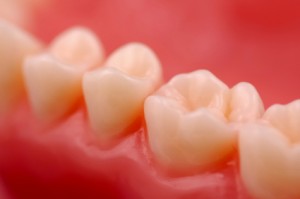 What causes gum disease?
What causes gum disease?
Our mouths are full of bacteria. These bacteria, along with mucus and other particles, constantly form a sticky, colorless “plaque” on teeth. Brushing and flossing help get rid of plaque. Plaque that is not removed can harden and form “tartar” that brushing doesn’t clean. Only a professional cleaning by a dentist or dental hygienist can remove tartar.
What if I have gum tissue that appears red and swollen?
If plaque is allowed to accumulate for 24 hours or more, the inflammation in your gum tissues becomes chronic. The continuous presence of bacteria makes it impossible for your body’s natural defenses to fight the infection. Chronic inflammation leads to a breakdown of the normal attachment between the teeth and the gums, causing the formation of “pockets.” Inside these pockets the infection continues to attack the tissues that support your teeth. Eventually this can lead to a breakdown of the bone that surrounds your teeth.
What if I have teeth that are getting loose, or a painful area in the gums?
If you experience these symptoms, the infection has progressed a long way from the “silent” stage. It is time to seek immediate professional help.
Why do I have bad breath?
Bad breath is another sign of accumulated plaque. The bacteria in plaque may emit gases that have an unpleasant odor.
Why are my gums are sensitive to hot or cold?
Chronic inflammation can also cause the gums to recede, exposing the roots of the teeth in which nerves may be close to the surface, leading to sensitivity to heat and cold.
Why do my gums bleed when I brush my teeth?
Some people think that gums bleed from brushing too hard. In fact, healthy gum tissues will not bleed with normal brushing. The usual cause of bleeding gums is an accumulation of dental plaque in the areas where your teeth meet your gums. Plaque is a film of bacteria, which accumulates on your teeth. If you are not brushing and flossing effectively, plaque irritates your gum tissues and causes an inflammation and swelling called gingivitis. This causes your gums to bleed easily on contact with a toothbrush or floss.
Who gets gum disease?
People usually don’t show signs of gum disease until they are in their 30s or 40s. Men are more likely to have gum disease than women. Although teenagers rarely develop periodontitis, they can develop gingivitis, the milder form of gum disease. Most commonly, gum disease develops when plaque is allowed to build up along and under the gum line.
How is gum disease treated?
The main goal of treatment is to control the infection. The number and types of treatment will vary, depending on the extent of the gum disease. Any type of treatment requires that the patient keep up good daily care at home. The doctor may also suggest changing certain behaviors, such as quitting smoking, as a way to improve treatment outcome.
How can I keep my teeth and gums healthy?
- Brush your teeth twice a day (with a fluoride toothpaste).
- Floss regularly to remove plaque from between teeth. Or use a device such as a special brush or wooden or plastic pick recommended by a dental professional.
- Visit the dentist routinely for a check-up and professional cleaning.
- Don’t smoke.
Call Us: 954-568-9100
Contact us if you have a question or to
schedule your complimentary consultation!
Sources:
NIH Publication No. 12-1142, August 2012
http://www.nidcr.nih.gov/
